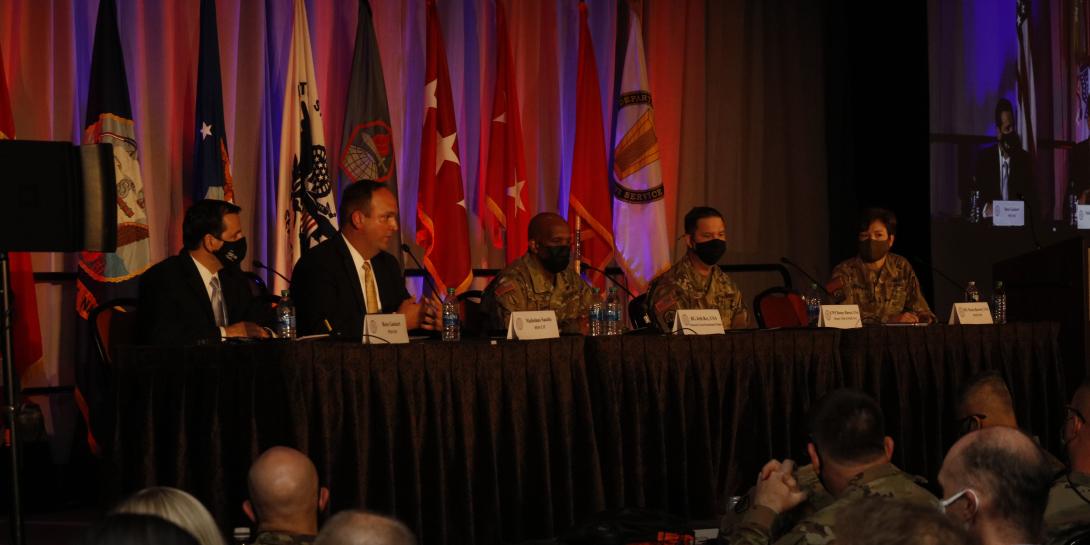Army Officials Outline Unified Network Technology Needs
In order to make the unified network vision a reality, the Army will need to adopt an array of technical capabilities, including 5G, zero trust cybersecurity, software-defined networks and data fabric.
Several Army officials participating on a unified network panel at the AFCEA TechNet Augusta conference in Augusta, Georgia, discussed some of the capabilities needed to converge the tactical and enterprise networks into one. Maj. Gen. Maria Barrett, USA, commander, Army Network Enterprise Technology Command (NETCOM), moderated the panel. It included Ross Guckert, program executive officer for enterprise information systems; Nicholaus Saacks, acting deputy program executive officer for command, control and communications-tactical; CW5 Danny Burns, USA, chief technology officer, deputy chief of staff, G-6; and Brig. Gen. Jeth Rey, USA, director, Network Cross-Functional Team.
MG Maria Barrett, USA, commander, NETCOM, says the need for a unified network is "very real."#AFCEATechNet
— George Seffers (pronounced See furs) (@gseffers) August 18, 2021
Guckert reported being excited about the Army’s modernization strategy, in part because it is tied to a five-year budget. “We’re considering very innovative approaches and investments in everything from 5G, WiFi, commercial solutions for classified, software-defined networks, zero trust, ICAM [identity credential access management], and regionalized and globalized SIPR [Secret Internet Protocol Router Network], just to name a few.”
He reported that a number of pilot programs have taken place and are ongoing to help inform the strategy.
“We are positioning ourselves to move as fast as the funding and the strategy will allow,” he said.
Guckert also noted that his office is prepared to use a range of acquisition tools, such as other transaction authorities, DevSecOps and incremental development “so that we can deliver this capability as fast as we can.”
Saacks suggested that data fabric is “critically important” to the Army’s network unification goals. “As we build out a different transport and have resilient transport options and PACE [primary, alternate, contingency and emergency] plans for how we’re going to communicate, it’s critically important that we have a way to define the data and get it to where it needs to be,” he said. “I don’t think we have a problem today that there’s not enough data. We have plenty of data available to us. The challenge today is we don’t have a structure in place to accurately tag the data or identify the data, prioritize it.”
Nicholaus Saaks, acting deputy @PEOC3T, says a data fabric as part of CS23 will all the movement of data across all echelons of the tactical network.#AFCEATechNet
— George Seffers (pronounced See furs) (@gseffers) August 18, 2021
While the service does have some of those capabilities, “There are a probably a lot of ways we can do that faster and smarter so that the data flows at a speed that’s relevant,” he added.
CW5 Burns described the technologies he considers foundational for a unified network. They include 5G, low-Earth orbit and near-Earth orbit satellite communications and ICAM.
Gen. Rey also noted the importance of data, especially in the Mission Partner Environment. “When we look at data and structure data and look at how we share data in the future, we always have to include our partners as part of that piece. If we’re going to see JADC2 [joint all-domain command and control] realized, it’s going to be from a [Mission Partner Environment] perspective where we’re sharing that data,” he said.
BG Jeth Rey, USA, director, Network Cross Functional Team: There is a broken line between the tactical [network] and the enterprise. If we don't get this right...soldiers are going to go around us.#AFCEATechNet
— George Seffers (pronounced See furs) (@gseffers) August 18, 2021
In the future, Gen. Rey added, how the Army creates, tags and standardizes data will be important. “If we continue to create data in the manner that we are—whether it’s sensing data, intel data, doesn’t matter—we’re going to be in the same place we’ve been in for the last four decades that I’ve been in the Army,” he said. “We have to look at this differently. We have to get to a cloud environment. We have to secure it. We have transport it. I don’t take my tactical Gmail to the field, but I still get to it when I’m there, so we have to figure this out.”
Gen. Barrett noted, “There does need to be a framework for how we’re going to fight this network. If you are willing to converge this, make it seamless. We do have to re-envision the roles and responsibilities at echelon.”





Comments